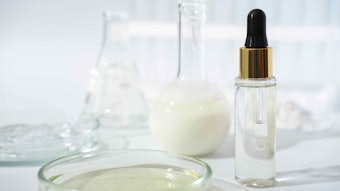Can a single surfactant both clean the skin and treat it? This article describes the dual functionality of zinc coceth sulfate (ZnCS) that appears to be based on its mildness and its ability to deposit zinc basic salts onto the skin. Divalent salts (usually magnesium salts) of alkyl ether sulfates are known for their skin mildness. ZnCS, obtained by a special synthesis and stabilized as regards hydrolysis, represents a new generation in the field of mild surfactants. It is provided with complex functional properties and a wide potential for special application in skin care.
The reason for such functionality is the same that, in the past, seemed to hinder most cosmetic applications: the easy precipitation of insoluble zinc compounds from anionic surfactant solutions containing zinc ions. Such a drawback represented a hurdle to the wide use of this surfactant in cleansing formulations. Indeed, it is also the key to its special activity in functional skin cleansing.
The ways to stabilize ZnCS solutions and the evaluation of some skin properties after treatment with such solutions are here described. Long-term effi cacy parameters seemed to be related to zinc species diffusion into the stratum corneum. Zinc species deposition onto skin has also been investigated.
Zinc and the Skin
Zinc can influence the activity of 90 enzymes or protein complexes in our body. Following intestinal adsorption, it is rapidly transported to the skin.1 Zinc is important in skin repair
processes and the morphogenesis of the skin. It is also important for collagen synthesis and fibroblast proliferation. Its deficiency leads to specific dermatitis, which responds promptly to oral or topical treatment.2 Such improvement does not seem to be only related to its
easy adsorption into the skin, but more probably to the activation of repair and anti-oxidant enzymes.3
The wide use of zinc oxide and zinc carbonate (calamine) has an historical background in diaper rash baby cream, lenitive ointments and lotions that are astringents, mild antibacterials and soothing agents.
From the time when zinc oxide was first recognized as beneficial in skin healing, zinc became the source of other common raw materials in cosmetics. More recently, zinc oxide in micronized form has found extensive applications in sunscreens, as an effective UVA filter.
Lenitive properties of insoluble zinc compounds seem to be related to their slow release of zinc ions, to the precipitation of inflammatory proteins on its active surface and to the slightly alkaline pH of suspensions. Probably, zinc inhibits the release of a specialized dendritic
type of T lymphocytes expressed in allergic reactions and stimulates IL-10 (an immune modulation cytokine) production by lympho-monocytes,4 a process that is benefi cial in the treatment of nickel allergies.
Nevertheless, toxicological precautions have induced European legislators to limit the concentration of soluble zinc ions in cosmetics to 1%, while no limits exist in the EEC for its insoluble derivatives (except for zinc sulfophenate and zinc pyrithione). In the U.S., zinc
oxide, carbonate and acetate are listed as safe and effective skin protectants for OTC drug products, while zinc pyrithione is an effective anti-dandruff agent described in the same monograph. Also in Japan, insoluble zinc salts are freely allowed, but limitations exist for the
soluble zinc chloride (0.1%), zinc sulfate (1% in detergents, 0.5% in all other products) and zinc undecylenate (3% in leave-on cosmetics). Zinc sulfophenate and zinc pyrithione have specific limitations and labeling requirements in both the U.S. and Japan. Occlusive patches at 25% zinc oxide are not irritant5 while neither zinc nor its salts are reported to be significant allergens. In the treatment of oral mucosa, zinc showed a protective effect.6,7










